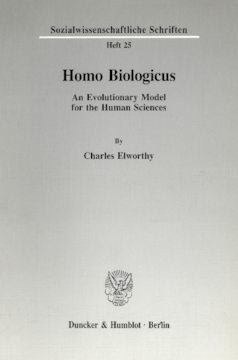Homo Biologicus

BOOK
Cite BOOK
Style
Format
Homo Biologicus
An Evolutionary Model for the Human Sciences
Sozialwissenschaftliche Schriften, Vol. 25
(1993)
Additional Information
Book Details
Pricing
Table of Contents
| Section Title | Page | Action | Price |
|---|---|---|---|
| Preface | vii | ||
| Acknowledgements | ix | ||
| Contents | xi | ||
| Illustrations | xiv | ||
| I. Introduction | 1 | ||
| II. The Elements of Evolution | 3 | ||
| 1. Hierarchies and Reductionism | 3 | ||
| 2. Elements of the Evolutionary Process | 6 | ||
| a) Inheritance, Replicators, and Vehicles | 6 | ||
| b) Variation | 9 | ||
| c) Selection | 13 | ||
| d) Genetic Drift | 16 | ||
| e) Isolation and Speciation | 17 | ||
| 3. Levels of Selection | 18 | ||
| a) Genets | 18 | ||
| b) Kin-Groups | 21 | ||
| c) Groups | 24 | ||
| 4. Other Replicators and Vehicles | 28 | ||
| III. Adaptations and their Characteristics | 34 | ||
| 1. The Meaning of Adaptation | 34 | ||
| 2. Adaptations from Four Perspectives | 41 | ||
| a) Phylogeny | 41 | ||
| b) Function | 47 | ||
| c) Mechanism | 48 | ||
| d) Ontogeny | 50 | ||
| 3. Analysing Adaptations | 52 | ||
| a) Maximisation Subject to Constraints | 52 | ||
| b) Optimisation and Maximisation | 59 | ||
| c) The Manifestation of Adaptations | 65 | ||
| IV. Evolution and the Human Psyche | 71 | ||
| 1. The Cognitive Level and Evolutionary Psychology | 71 | ||
| 2. Investigating the Cognitive Level | 74 | ||
| a) The Environment of Evolutionary Adaptedness | 74 | ||
| b) Cognitive Programs and Computational Theories | 75 | ||
| c) Darwinian Algorithms | 78 | ||
| d) Ontogeny and Behaviour | 82 | ||
| 3. Evolutionary Psychology and the Wason Selection Task | 83 | ||
| a) Content Effects on the Wason Selection Task | 83 | ||
| b) A Computational Analysis of Social Exchange | 86 | ||
| c) The “Look for Cheaters” Darwinian Algorithm | 89 | ||
| 4. Accounting for Hominid Cognitive Development | 93 | ||
| a) Encephalisation | 93 | ||
| b) The Capacity for Sociality | 101 | ||
| c) The “Balance of Power” Hypothesis | 103 | ||
| V. From Psychology to Behaviour | 113 | ||
| 1. Genet Maximisation | 113 | ||
| a) Specification of Somatic Maximisation | 113 | ||
| b) Habitat Selection | 118 | ||
| c) Responses to Hazards and Risks | 121 | ||
| d) Avoidance of Unprofitable Investment | 127 | ||
| 2. Kin-Group Maximisation | 133 | ||
| a) Specification of Kin-Group Maximisation | 133 | ||
| b) Sexual Preferences | 137 | ||
| c) Male Reproductive Strategies | 139 | ||
| 3. Group Maximisation | 146 | ||
| a) Specification of Group Maximisation | 146 | ||
| b) Obedience | 149 | ||
| c) Conformity | 153 | ||
| d) Obedience and Conformity as Community Effort | 157 | ||
| 4. Aggregate Maximisation and Non-Optimality | 165 | ||
| VI. Homo Biologicus and Human Characteristics | 168 | ||
| 1. Characterising Homo Biologicus | 168 | ||
| 2. Homo Biologicus versus Homo Oeconomicus | 181 | ||
| a) Choice under Uncertainty | 181 | ||
| b) Excess Volatility in Securities Markets | 188 | ||
| c) Household Behaviour and Family Altruism | 193 | ||
| d) War | 196 | ||
| 3. Linking the Human Sciences | 201 | ||
| 4. Evolutionary Research and Human Characteristics | 212 | ||
| a) Opposition to Evolutionary Research | 212 | ||
| b) Consequences of “Biophobia” | 215 | ||
| c) Diversity and Discrimination | 218 | ||
| d) Determinism and Freedom | 221 | ||
| VII. Summary and Implications | 226 | ||
| Glossary | 228 | ||
| Subject Index | 239 | ||
| Author Index | 249 | ||
| Selected Bibliography | 257 |
